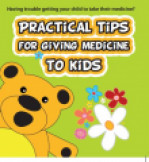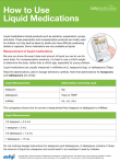Giving medicines to babies and children
Key points about giving medicines to babies and children
- Giving medicines to babies and children can be tricky, especially when they are feeling unwell and a bit grumpy.
- However, giving your child the correct dose at the correct time is important.
- Read tips on how to give medicines to babies and children.

Forcing your child to take their medicine can lead to fear, vomiting, choking or injury. Talk to your child about their medicine and let them know it will help them feel better.
Always store medicines out of reach and out of sight of children.
Image credit: Australian Prescriber(external link)
Always use a proper measuring cup, spoon or syringe to give the correct dose – don’t use a kitchen spoon. Some liquid medicines come with their own measuring cup, spoon or syringe or you can buy one from your pharmacy.
- Syringes: These help to measure the exact dose. Gently squirt the medicine into your child's lower cheek, not at the back of their throat as this can cause choking. Read more about how to use medicine syringes safely.
- Measuring cup: These are for children old enough to drink from a cup, and have numbers on the side to help you measure the right dose. Put the cup at eye level on a flat surface when you measure the dose to make sure you have the right amount.
- Dosing spoon: These are for children who can drink from a spoon. They have a tube to measure the dose with a spoon at the end.
- Droppers: These are best for children who can't drink from a cup.
It’s important that children take their medicines as prescribed. Let your doctor know if you have problems giving your child their medicine.
For more detailed information on giving liquid medicine to your child, see the following resources:
- Giving medicines to children PHARMAC, Ministry of Health, Plunket and Paediatric Society, NZ (English(external link), te reo Māori(external link), Samoan(external link), Tongan(external link), Chinese (simplified)(external link), Chinese (traditional)(external link), Korean(external link), Somali(external link), Spanish(external link), Thai(external link), Vietnamese(external link))
- How to give medicines – liquid medicine using an oral syringe with a 'bung' [PDF, 773 KB] Medicines for Children, UK
- How to give medicines – liquid medicine using an oral syringe from a bottle without a bung(external link) Medicines for Children, UK
- How to use liquid medications(external link) Safe Medication, US
Children may not like the taste and smell of medicine. Here are some tips to help you.
- Give your child a drink of fruit juice or milk straight after the medicine.
- Give your child an ice block to numb their taste buds before giving them the medicine.
- Get your child to hold their nose for a few seconds while taking their medicine to dull the taste.
- Give a reward such as a sticker and praise them for taking their medicine.
- Get your child involved in decisions. Ask them to choose a syringe or a medicine cup to take their medicine, or if they would like their medicine before or after bath time.
Some tablets and capsules must be swallowed whole with water, whereas others can be chewed or dissolved in water or juice, put on the tongue or mixed with a small amount of food.
Check which type of tablet you have. Some tablets can be crushed but always check with your pharmacist first to make sure it’s okay before you do.
Most capsules must be swallowed whole, but some may be chewed, or opened and sprinkled on food. Check with your pharmacist first to make sure it’s okay to pull apart a capsule – some medicines may not work well or may harm the stomach if you break the capsule.
For more detailed information on giving tablets and capsules to children, see the following resources:
- How to give medicines – tablets(external link) Medicines for Children, UK
- How to give medicines – capsules(external link) Medicines for Children, UK
- Encouraging children to swallow tablets or capsules(external link) BPAC, NZ
The following resources have a few general tips that may be helpful:
- Practical tips for giving medicine to kids(external link) Pharmac, NZ
- How to safely give medicines to children(external link) Medsafe, NZ
- Encouraging children to swallow tablets or capsules(external link) BPAC, NZ
For information on ways to give other types of medicines see the following:
References
- Smith L, Leggett C, Borg C. Administration of medicines to children – a practical guide(external link) Aust Prescr. 2022;45(6):188-192
Brochures
Giving medicines to children
PHARMAC, Ministry of Health, Plunket and Paediatric Society, NZ
Liquid medications - how to use
Safe Medication, US, 2021

Medicines and side effects
Healthify He Puna Waiora, NZ, 2024
Credits: Sandra Ponen, Pharmacist, Healthify He Puna Waiora. Healthify is brought to you by Health Navigator Charitable Trust.
Reviewed by: Angela Lambie, Pharmacist, Auckland
Last reviewed:
Page last updated:







